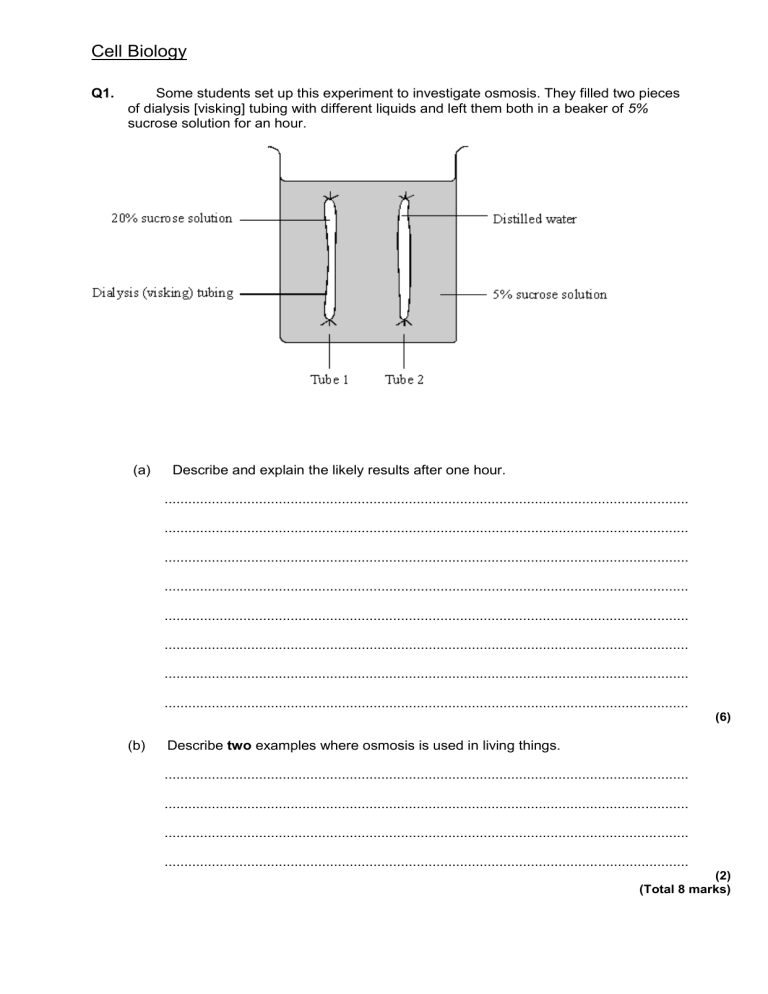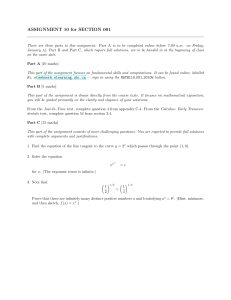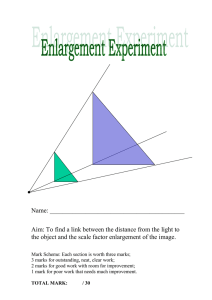
Cell Biology Q1. Some students set up this experiment to investigate osmosis. They filled two pieces of dialysis [visking] tubing with different liquids and left them both in a beaker of 5% sucrose solution for an hour. (a) Describe and explain the likely results after one hour. ..................................................................................................................................... ..................................................................................................................................... ..................................................................................................................................... ..................................................................................................................................... ..................................................................................................................................... ..................................................................................................................................... ..................................................................................................................................... ..................................................................................................................................... (6) (b) Describe two examples where osmosis is used in living things. ..................................................................................................................................... ..................................................................................................................................... ..................................................................................................................................... ..................................................................................................................................... (2) (Total 8 marks) Q2. The diagram shows an animal cell. (a) Name each labelled part and give its function. A Name ............................................................................................................... Function .......................................................................................................... ......................................................................................................................... B Name .............................................................................................................. Function ......................................................................................................... ........................................................................................................................ C Name .............................................................................................................. Function ......................................................................................................... ........................................................................................................................ (6) (b) (i) This plant cell also contains chloroplasts, a cell wall and a vacuole. Label each of these parts on the diagram. (3) (ii) Give the function of these parts of a plant cell. Chloroplast function ......................................................................................... ........................................................................................................................... Cell wall function ............................................................................................. ........................................................................................................................... Vacuole function .............................................................................................. ........................................................................................................................... (3) (Total 12 marks) Q3. The photograph shows some cells in the root of an onion plant. By UAF Center for Distance Education [CC BY 2.0], via Flickr (a) Cells X and Y have just been produced by cell division. (i) Name the type of cell division that produced cells X and Y. ............................................................................................................... (1) (ii) What happens to the genetic material before the cell divides? ............................................................................................................... (1) (Total 2 marks) Q5. Some students investigated the effect of pH on the growth of one species of bacterium. They transferred samples of bacteria from a culture of this species to each of eight flasks. Each flask contained a solution of nutrients but at a different pH. After 24 hours, the students measured the amount of bacterial growth. (a) It was important that the flasks in which the bacteria grew were not contaminated with other microorganisms. Describe two precautions the students should have taken to prevent this contamination. 1 .................................................................................................................................. ..................................................................................................................................... 2 .................................................................................................................................. ..................................................................................................................................... (2) (b) To see the effect of pH on the growth of the bacteria, other conditions should be kept constant. Suggest two conditions which should have been kept constant for all eight flasks. 1 .................................................................................................................................. 2 .................................................................................................................................. (2) (c) The graph shows the results of the investigation. The students wanted to find the best pH for the growth of this species of bacterium. (i) Use the graph to estimate the pH at which the bacteria would grow best. pH .............................. (1) (ii) What could the students do to find a more accurate value for the best pH for growth of the bacteria? ........................................................................................................................... ........................................................................................................................... (1) (Total 6 marks) Q6. Plant roots obtain some of their mineral salts from the soil by active transport. What is involved in active transport? ............................................................................................................................................... . ............................................................................................................................................... . ............................................................................................................................................... . ............................................................................................................................................... . ............................................................................................................................................... . ............................................................................................................................................... . ............................................................................................................................................... . ............................................................................................................................................... . (Total 4 marks) Q7. The photograph shows a red blood cell in part of a blood clot. The fibres labelled X are produced in the early stages of the clotting process. (a) Suggest how the fibres labelled X help in blood clot formation. ..................................................................................................................................... (1) (b) The average diameter of a real red blood cell is 0.008 millimetres. On the photograph, the diameter of the red blood cell is 100 millimetres. Use the formula to calculate the magnification of the photograph. Diameter on photograph = Real diameter × Magnification ..................................................................................................................................... ..................................................................................................................................... ..................................................................................................................................... Magnification = .............................................................. (2) (c) Some blood capillaries have an internal diameter of approximately 0.01 millimetres. (i) Use information given in part (b) to explain why only one red blood cell at a time can pass through a capillary. ........................................................................................................................... (1) (ii) Explain the advantages of red blood cells passing through a capillary one at a time. ........................................................................................................................... ........................................................................................................................... ........................................................................................................................... ........................................................................................................................... ........................................................................................................................... ........................................................................................................................... (3) (Total 7 marks) M1. (a) award 3 marks per tube for each key idea for tube 1: expands or gets firmer or bigger or inflates it gains water because the concentration of water is less than its surroundings make sure answer is about water movement and not sucrose solution 3 for tube 2 gets floppy or flaccid or contracts it loses water because the concentration of water is greater than its surroundings 3 (b) any 2 from: uptake of water by root (hair) or movement from cell to cell within plant do not credit references to diffusion unless it is clear that the candidate is referring to the diffusion of water guard cell function maintain turgor water absorption in the large intestine reabsorption of water from the nephron or collecting duct or in kidney or osmoregulation in kidney allow osmosis in other animals if some use is shown 2 [8] M2. (a) A cytoplasm 1 where (chemical) reactions take place do not accept where cell functions take place 1 or carries/holds the organelles/named organelles / named chemicals (including nutrients) do not accept keeps the shape of the cell or contains water or presses out on the membrane allow: keeps cell turgid allows transport through the cell B membrane do not accept by themselves: protects cell gives shape 1 controls what enters/leaves the cell 1 or contains the cell/holds the cell together do not accept keeps harmful substances out or allows movement into and out of the cell C nucleus 1 contains the genetic material/DNA/genes/chromosomes do not accept: brain of the cell stores information/instructions tells cell what to do or controls (the activity) of the cell 1 (b) (i) one mark for each correctly labelled part cell wall do not accept anything inboard of the inner edge vacuole accept anything inboard of transplant chloroplast: site of photosynthesis/ for photosynthesis accept word equation or balanced equation 1 cell wall: supports the cell/keeps the shape/keeps it rigid do not accept protects the cells 2 (ii) vacuole: acts as reservoir for water / chemicals/(cell)/sap 3 or keeps cell turgid/pushes content to edge or maintains concentration gradient or allows cell elongation (not growth) 1 [12] M3. (a) (i) mitosis correct spelling only 1 (ii) replicates / doubles / is copied / duplicates accept cloned ignore multiplied / reproduced 1 [2] M5. (a) any two from: • sterilise / kill microorganisms ignore ‘cleaning’ / ‘disinfect’ ignore ‘germs’ • method of sterilisation eg apparatus / media sterilised in oven / autoclave allow pressure cooker / boiling water • pass flask mouth / pipette tip / loop / test tube mouth through flame • work near a flame • minimise opening of flask / test tube or hold non-vertical allow idea of sealing / covering or prevent entry of air 2 (b) any two from: • temperature ignore references to time / type of bacterium • concentration / amount of nutrients / ions • type of nutrient • volume / amount of solution • amount of bacteria added • agitation or amount of oxygen 2 (c) (i) 7.5 accept in range 7.4 – 7.6 1 (ii) use more pH values around / close to pH 7.5 / between 7 and 8 1 [6] M6. any four from molecules / ions do not credit mineral salts move(d) through / across the cell wall / membrane against (a / the) concentration gradient by a series of chemical reactions (because) diffusion cannot occur energy (required) (supplied by) respiration oxygen required for respiration (to occur) [4] M7. (a) hold cells together or prevent flow of cells or trap cells 1 (b) 12500 if correct answer, ignore working / lack of working for 1 mark ignore any units 2 (c) (i) size RBC approximately same size capillary or no room for more than one cell or only one can fit or RBC is too big allow use of numbers do not accept capillaries are narrow 1 (ii) more oxygen released (to tissues) or more oxygen taken up (from lungs) 1 and any two from: • slows flow or more time available • shorter distance (for exchange) or close to cells / capillary wall • more surface area exposed 2 [7]


